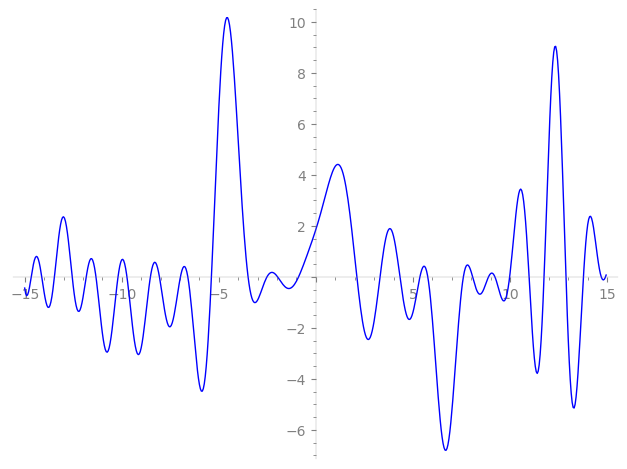| L(s) = 1 | + (−0.702 − 1.21i)2-s + (1.64 − 2.85i)3-s + (0.0118 − 0.0205i)4-s + (1.08 + 1.87i)5-s − 4.63·6-s + (2.39 − 1.11i)7-s − 2.84·8-s + (−3.93 − 6.81i)9-s + (1.52 − 2.64i)10-s + (−0.5 + 0.866i)11-s + (−0.0391 − 0.0678i)12-s − 13-s + (−3.04 − 2.13i)14-s + 7.15·15-s + (1.97 + 3.42i)16-s + (1.92 − 3.32i)17-s + ⋯ |
| L(s) = 1 | + (−0.497 − 0.860i)2-s + (0.951 − 1.64i)3-s + (0.00594 − 0.0102i)4-s + (0.484 + 0.839i)5-s − 1.89·6-s + (0.906 − 0.421i)7-s − 1.00·8-s + (−1.31 − 2.27i)9-s + (0.482 − 0.834i)10-s + (−0.150 + 0.261i)11-s + (−0.0113 − 0.0195i)12-s − 0.277·13-s + (−0.813 − 0.571i)14-s + 1.84·15-s + (0.493 + 0.855i)16-s + (0.465 − 0.806i)17-s + ⋯ |
\[\begin{aligned}\Lambda(s)=\mathstrut & 1001 ^{s/2} \, \Gamma_{\C}(s) \, L(s)\cr =\mathstrut & (-0.988 - 0.151i)\, \overline{\Lambda}(2-s) \end{aligned}\]
\[\begin{aligned}\Lambda(s)=\mathstrut & 1001 ^{s/2} \, \Gamma_{\C}(s+1/2) \, L(s)\cr =\mathstrut & (-0.988 - 0.151i)\, \overline{\Lambda}(1-s) \end{aligned}\]
Particular Values
| \(L(1)\) |
\(\approx\) |
\(1.864019053\) |
| \(L(\frac12)\) |
\(\approx\) |
\(1.864019053\) |
| \(L(\frac{3}{2})\) |
|
not available |
| \(L(1)\) |
|
not available |
\(L(s) = \displaystyle \prod_{p} F_p(p^{-s})^{-1} \)
| $p$ | $F_p(T)$ |
|---|
| bad | 7 | \( 1 + (-2.39 + 1.11i)T \) |
| 11 | \( 1 + (0.5 - 0.866i)T \) |
| 13 | \( 1 + T \) |
| good | 2 | \( 1 + (0.702 + 1.21i)T + (-1 + 1.73i)T^{2} \) |
| 3 | \( 1 + (-1.64 + 2.85i)T + (-1.5 - 2.59i)T^{2} \) |
| 5 | \( 1 + (-1.08 - 1.87i)T + (-2.5 + 4.33i)T^{2} \) |
| 17 | \( 1 + (-1.92 + 3.32i)T + (-8.5 - 14.7i)T^{2} \) |
| 19 | \( 1 + (-1.02 - 1.78i)T + (-9.5 + 16.4i)T^{2} \) |
| 23 | \( 1 + (2.62 + 4.54i)T + (-11.5 + 19.9i)T^{2} \) |
| 29 | \( 1 + 1.87T + 29T^{2} \) |
| 31 | \( 1 + (1.46 - 2.54i)T + (-15.5 - 26.8i)T^{2} \) |
| 37 | \( 1 + (-5.16 - 8.95i)T + (-18.5 + 32.0i)T^{2} \) |
| 41 | \( 1 + 5.46T + 41T^{2} \) |
| 43 | \( 1 + 1.35T + 43T^{2} \) |
| 47 | \( 1 + (3.74 + 6.48i)T + (-23.5 + 40.7i)T^{2} \) |
| 53 | \( 1 + (-6.06 + 10.5i)T + (-26.5 - 45.8i)T^{2} \) |
| 59 | \( 1 + (-4.29 + 7.43i)T + (-29.5 - 51.0i)T^{2} \) |
| 61 | \( 1 + (-7.22 - 12.5i)T + (-30.5 + 52.8i)T^{2} \) |
| 67 | \( 1 + (-4.45 + 7.72i)T + (-33.5 - 58.0i)T^{2} \) |
| 71 | \( 1 - 6.06T + 71T^{2} \) |
| 73 | \( 1 + (4.52 - 7.84i)T + (-36.5 - 63.2i)T^{2} \) |
| 79 | \( 1 + (-7.56 - 13.1i)T + (-39.5 + 68.4i)T^{2} \) |
| 83 | \( 1 + 6.95T + 83T^{2} \) |
| 89 | \( 1 + (-7.64 - 13.2i)T + (-44.5 + 77.0i)T^{2} \) |
| 97 | \( 1 - 4.81T + 97T^{2} \) |
| show more | |
| show less | |
\(L(s) = \displaystyle\prod_p \ \prod_{j=1}^{2} (1 - \alpha_{j,p}\, p^{-s})^{-1}\)
Imaginary part of the first few zeros on the critical line
−9.732929117667898131487560996851, −8.524384292846191040179578432349, −8.059324716100596717586300963666, −6.97776048320565777939248940941, −6.59705909516067751429038867735, −5.38209005870274294914306166835, −3.49345759619429837895789451840, −2.52072739983723604574680979962, −1.97322878785884560808950577716, −0.892877928768443974998822678092,
2.11026237744444017102505501461, 3.30421007166810852093372802741, 4.32996285043971376627668812880, 5.35743204280368072731385547809, 5.76254079305783125341461866738, 7.59594473809640041914800324934, 8.072309903526966046694427280999, 8.890203382867635227637412624850, 9.220887196115134592378264152895, 9.979001839446211334490468346886

